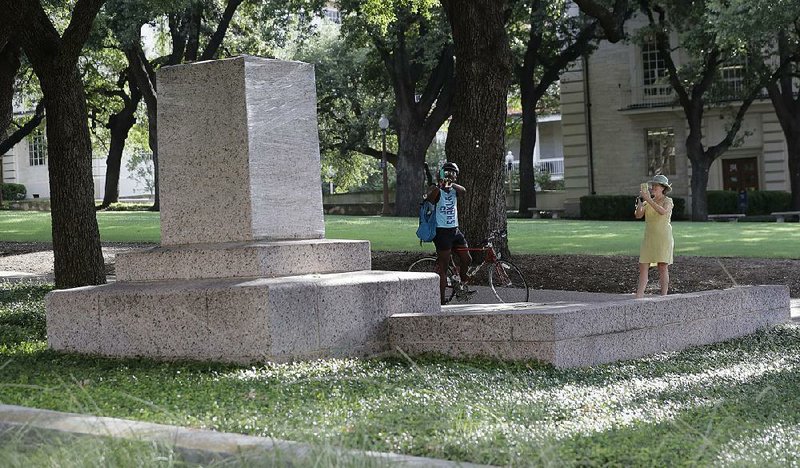AUSTIN, Texas -- The University of Texas quickly removed statues of Robert E. Lee and other prominent Confederate figures overnight from the main area of the Austin campus early Monday, just hours after the school's president ordered they be taken down.
University President Greg Fenves abruptly announced late Sunday that the statues would be removed, saying such monuments have become "symbols of modern white supremacy and neo-Nazism." Crews worked through the night amid a heavy police presence.
The school blocked off the area, and some arguments occurred among those gathered. But all the statues of Lee, Confederate Gen. Albert Sidney Johnston and Confederate Postmaster General John H. Reagan were successfully taken down.
By late morning, people walking by were stopping to gawk at the four pedestals, empty except for some construction debris and the bolts that once held the statues in place. Some snapped selfies, while a few climbed up the structures where the statues once stood.
But the scene remained peaceful and the area largely deserted. The university doesn't begin classes until next week.
Fenves said the statues would be moved to the Briscoe Center for American History on campus. The university in 2015 moved a statue of former Confederate President Jefferson Davis from its perch near the campus clock tower, the same area as the other statues, to the history museum.
As the statues were being taken down, less than 30 people, both supporters and opponents of Fenves' order, congregated behind barricades near the statues. Among them was Mark Peterson, who identified himself as a University of Houston student. He was seething at the removal of the statues.
"I hate the erasure of history and my people's history ... people of European descent who built this country," the 22-year-old said. "It burns me to my core."
Mike Lowe, an activist for the removal of Confederate statues in San Antonio, was driving to Dallas when he heard the statues were coming down, turned around and drove to campus. Lowe, who is black, engaged in a brief but tense argument with a white male protester until police stepped in to separate them.
"They have no other reasons than 'you are erasing our history.' Their reasoning is flawed. These monuments represent white supremacy, and black lives haven't mattered in this country the same as a white man's matters," the 37-year-old Lowe said.
The debate over public memorials for Confederate figures roared into national conversation this month after a woman was killed and 19 were injured when a car drove into a crowd of people in a clash between white supremacists and counter-protesters in Charlottesville, Va.
"Last week, the horrific displays of hatred at the University of Virginia and in Charlottesville shocked and saddened the nation. These events make it clear, now more than ever, that Confederate monuments have become symbols of modern white supremacy and neo-Nazism," Fenves said in a statement.
Moving the Davis statue in 2015 was a much more deliberate effort. The Davis statue had long been a target of vandalism. Fenves convened a special task force to discuss its future after a shooting rampage by a white supremacist at a Charleston, S.C., church and ultimately decided it should come down.
Confederate groups tried to block the removal of the Davis statue and the Sons of Confederate Veterans sued to stop it, but a state district judge sided with the school.
In Bradenton, Fla., several hundred supporters of Black Lives Matter and other groups rallied Monday evening to demand the removal of a Confederate monument that has stood for decades outside a courthouse. The protest also drew a smaller number of people who wanted the monument, now clad in protective plywood, to stay.
Bradenton leaders had the plywood put up around the monument in recent days, after a similar debate in Charlottesville led to a violent white nationalist rally Aug. 12 in which hundreds clashed violently.
On Monday evening, activists opposed to the Bradenton monument stood shoulder to shoulder with elderly people waving signs against racism. Some signs read: "No racism, no hate." Activists marched a few blocks from the city's waterfront to the courthouse plaza, where they gave speeches and chanted.
A handful of people stood in opposition, including a person with a sign with a swastika and others waving a Confederate flag.
"It's history, get over it!" a white woman hollered.
"It's still happening," a black man yelled back.
RELATED ARTICLE
http://www.arkansas…">Bomb plot targets Houston monument
Information for this article was contributed by Tamara Lush of The Associated Press.
A Section on 08/22/2017
